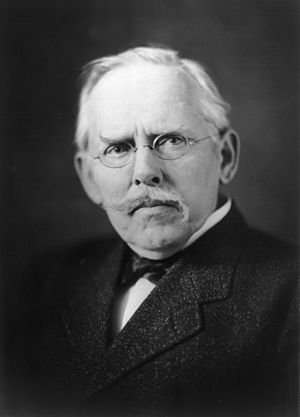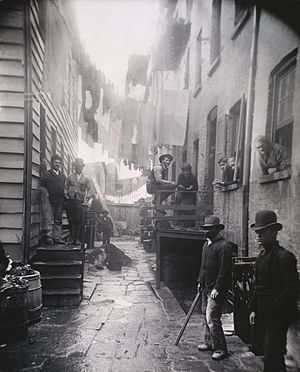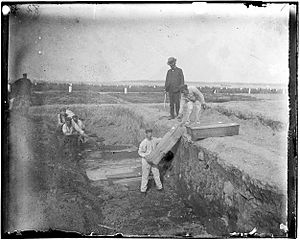Jacob Riis facts for kids
Quick facts for kids
Jacob Riis
|
|
|---|---|

Riis in 1906
|
|
| Born | May 3, 1849 Ribe, Denmark
|
| Died | May 26, 1914 (aged 65) Barre, Massachusetts, U.S.
|
| Nationality | Danish, American |
| Known for | Social reform, journalism, photography |
Jacob August Riis (pronounced REESS; May 3, 1849 – May 26, 1914) was a Danish-American journalist and photographer. He was also a social reformer, meaning he worked to improve society. Riis used his skills to show the difficult lives of poor people in New York City. He wanted to help them by showing their living conditions to richer people.
Riis is famous for using early flash photography. This allowed him to take pictures in dark places, like the crowded, unhealthy buildings where many poor families lived. He is considered one of the important figures in the history of photography.
Biography of Jacob Riis
Early Life in Denmark
Jacob Riis was born in 1849 in Ribe, Denmark. He was one of 15 children. His father, Niels Edward Riis, was a schoolteacher and writer. His mother was Carolina Riis. Jacob enjoyed reading books by authors like Charles Dickens, which his father encouraged.
When Jacob was 11, his younger brother Theodore drowned, which was a very sad event for his family. Around the same age, Jacob showed his caring nature. He gave all his money to a poor family in Ribe so they could clean their dirty home. His mother then went to help them too.
Jacob wanted to be a carpenter, even though his father hoped he would become a writer. At 16, he fell in love with Elisabeth Gjørtz. However, her father did not approve, so Riis had to go to Copenhagen to finish his carpentry training. He returned to Ribe in 1868, but jobs were hard to find. Elisabeth also turned down his marriage proposal. Because of this, Riis decided to move to the United States.
Moving to the United States
In 1870, at age 21, Riis moved to America to find work as a carpenter. He traveled from Copenhagen to Glasgow, then boarded a ship called the Iowa to New York. He arrived in New York on June 5, 1870.
When Riis arrived, New York City was growing fast. Many people were moving to cities after the American Civil War. Millions of people, including many immigrants, came to urban areas. This led to very crowded neighborhoods, especially in places like the Lower East Side. In the 1880s, hundreds of thousands of people lived in a small area, often 10 or 15 to a single room. These places were dirty and full of disease.
Riis himself experienced poverty. He worked many different jobs, like carpentry and mining. He even tried to join the French army during a war, but it didn't work out. He often had little money, sometimes sleeping on tombstones or in dirty police lodging-houses. Once, his gold locket, which held a strand of Elisabeth's hair, was stolen from him. These hard experiences helped him understand the struggles of the poor.
After many difficulties, Riis found stable work as a salesman. He eventually returned to New York City.
Becoming a Journalist
Riis saw an advertisement for an editor at a newspaper on Long Island. He got the job but quickly realized the main editor was dishonest. So, he left after two weeks.
Unemployed again, Riis was sitting near the Cooper Union building one day. His old telegraphy teacher saw him and told him about a trainee job at the New York News Association. Riis got the job after successfully writing about a luncheon.
Riis was good at his job and was promoted to editor of a weekly newspaper called the News. However, this newspaper soon went out of business. Around this time, he learned that Elisabeth Gjørtz's fiancé had died. Riis wrote to Elisabeth and proposed to her. He then bought the News company with his savings.
Riis worked very hard and paid off his debts. He was now independent and could write about the politicians who had once employed him. Elisabeth accepted his proposal, asking him to come to Denmark. The politicians then offered to buy back his newspaper for five times what he paid. This allowed Riis to return to Denmark with enough money to marry Elisabeth.
After they married, Jacob and Elisabeth came back to New York. Riis worked as an editor for a short time. He also used a "magic lantern" projector to show advertisements. This was a new idea and was quite successful.
Working for the Tribune
A neighbor, who was an editor at the New-York Tribune, helped Riis get a job as a police reporter. Riis worked from an office across from police headquarters on Mulberry Street. This area was known as "Death's Thoroughfare" because it was one of the most crime-ridden and poorest parts of New York.
Working the night shift in these immigrant neighborhoods, Riis saw the terrible conditions firsthand. His own past experiences with poverty made him want to help. He became one of the first journalists to write about social problems, hoping to bring about change.
Pioneering Photography

Riis wanted to show the terrible living conditions more clearly than words could. Sketching wasn't his strong suit. Regular cameras in the 1880s were too slow to take pictures in dark indoor spaces.
Then, in 1887, Riis learned about a new invention: flash photography. German inventors had created a flash powder that could be used to take pictures in the dark. This was a huge step forward for photography.
Riis quickly saw the potential of this new flash. He teamed up with some amateur photographer friends. Their first report, with drawings based on their photos, was published in The New York Sun in February 1888. It described "pictures of Gotham's crime and misery by night and day."
Riis and his friends were among the first Americans to use flash photography. Early flash methods were dangerous, sometimes involving igniting magnesium powder in a frying pan! Riis soon bought his own camera and learned to develop his own photos.
For three years, Riis took his own photos and collected others from professionals and amateurs. This collection became the basis for his work. Because he worked at night, he could photograph the worst parts of the New York slums. He showed the dark streets, crowded apartments, and difficult lives of the poor and criminals, especially around Mulberry Street.
His powerful photos of Mulberry Street helped convince New York officials to tear down the worst parts of the slum. In 1897, Mulberry Bend was turned into Mulberry Park. This park greatly improved the neighborhood. Riis was very happy, saying that children now had a safe place to play.
Sharing His Message
Riis tried to get his photo essays published in magazines. But when one editor liked his photos but not his writing, Riis decided to speak directly to the public instead.
It was hard to find places to speak. Some churches were afraid that his talks would upset their wealthy members or powerful landlords. However, with help from others, Riis was able to give his first lecture at the Broadway Tabernacle church.
Riis and a friend used magic lantern slides to show his photographs during their lectures. They didn't make much money, but these talks helped many people see the problems Riis was describing. They also allowed him to meet important people who could help make changes, like an editor from Scribner's Magazine.
Writing Books
An 18-page article by Riis, titled How the Other Half Lives, appeared in Scribner's Magazine in late 1889. It included 19 of his photographs, shown as line drawings. This article led to an invitation for Riis to expand his work into a full book.
Riis worked on the book at night, after his day job as a reporter and his evening public speaking engagements. How the Other Half Lives, with the subtitle "Studies Among the Tenements of New York," was published in 1890. It was one of the first books to use many halftone photographic reproductions, making the pictures look more like actual photos.
The book sold well and was widely discussed. It helped people understand the need for social improvements. It also inspired other books about life in the city.
Riis wrote a sequel called Children of the Poor (1892), which focused on the lives of specific children he had met.
His autobiography, The Making of an American (1901), tells the story of his early life in Denmark and his struggles as an immigrant in the U.S. It explains how he became a reporter and how his work among immigrants made him want to fight for social reforms. Riis wanted to show that America offered great opportunities for those who were brave enough to take chances.
Friendship with Theodore Roosevelt

Jacob Riis had a close friendship and working relationship with Theodore Roosevelt, who later became president of the United States. Their friendship began in 1895 when Roosevelt became the head of the New York City Police Department. Roosevelt asked Riis to show him what police work was like at night.
On their first tour, they found that many police officers were not doing their jobs. Riis wrote about this, and Roosevelt made sure the police force became more active. Roosevelt was deeply moved by Riis's work and his strong sense of justice. He became Riis's lifelong friend. Roosevelt even closed the dirty police lodging rooms where Riis had once slept.
When Roosevelt became president, he wrote a tribute to Riis in a magazine. He called Riis "the most useful citizen of New York." Roosevelt admired Riis's ability to show others what he saw and felt. He believed Riis was a powerful force for change who never gave up. Roosevelt was so influenced by Riis that he helped create the White House Conference on Children. This conference aimed to help children like those Riis showed in his books.
Important Public Works
One of Riis's most important efforts was showing the poor condition of New York's water supply. In 1891, he wrote a five-column story called "Some Things We Drink." He took his camera to the watershed area, where the city's drinking water came from. He photographed towns that were dumping sewage directly into the water.
Riis asked doctors how long cholera bacteria could live in running water. They said about seven days. This proved his point that the water was dangerous. His story led New York City to buy land around the New Croton Reservoir. This action likely saved many New Yorkers from a cholera epidemic.
Riis also worked hard to have the slums around Five Points torn down and replaced with a park. His writings led to an investigation of unsafe buildings. This resulted in the Small Park Act of 1887. Riis was not invited to the park's opening in 1897, but he went anyway. During the speeches, the street cleaning commissioner gave Riis credit for the park. The public cheered for him, shouting, "Hooray, Jacob Riis!" Other parks were also created because of his efforts.
Later Life and Legacy
Riis published his autobiography, The Making of an American, in 1901. His son, John Riis, became a forest ranger. Another son, Roger Williams Riis, also became a reporter and activist.
In 1905, Jacob Riis's first wife, Elisabeth, passed away. Riis remarried in 1907 to Mary Phillips. They moved to a farm in Barre, Massachusetts. Jacob Riis died at this farm on May 26, 1914. His second wife, Mary, continued his work and lived until 1967.
Social Views
Some people thought Riis disliked the rich because he cared so much for the poor. However, Riis was comfortable around wealthy people and often asked them for their support. He usually stayed out of party politics. But he was so disgusted by the corruption of Tammany Hall (a powerful political group) that he switched from supporting the Democratic Party to the Republican Party.
Memorials and Tributes
- Jacob Riis Park, a large park on the Rockaway Peninsula in Queens, New York City.
- Jacob Riis Triangle, in Richmond Hill, Queens.
- Jacob Riis Playground, in Queens.
- P.S. 126 The Jacob Riis Community School, a public school in New York City.
- Jacob Riis Settlement House, a community organization in Long Island City, Queens.
- Jacob Riis Houses, a public housing complex in Manhattan.
- Jacob Riis Park Historic District, a historic area listed on the National Register of Historic Places.
- Riis Park in Chicago.
- Jacob A. Riis Museum, in Ribe, Denmark.
- A statue of Jacob A. Riis in Ribe, Denmark.
- Jacob A. Riis High School, an all-boys school in Los Angeles, California.
Images for kids
See also
 In Spanish: Jacob Riis para niños
In Spanish: Jacob Riis para niños




